Evacuee Norman Sherry tells us about his time in Chrishall during the Second World War (taken from an article sent to Mrs Cranwell in 2002). Norman arrived with a group of 14 children who were evacuees in the village. His memories are still very clear of the enjoyable time he had. So if you are ready, let’s go back to 1939…
Clara Negus, to be known thereafter as ‘Auntie’ for the rest of her life, led me away from one side of the village green to the other and a small wattle-and-daub built into an oak frame, cottage hidden away behind a tall hawthorn hedge and a large (and very climbable) yew tree. This was to be my home for the next three years. [The cottage on the left in the picture above.]
I was greeted by the rest of the family: ‘Uncle’ William Negus and their three children; Wally, later to leave for the Royal Navy, Edie and Rosie* (Ed. note: Doris not Rosie), the last-named accompanied by her husband Wilf Pitches. Duly inspected and fed I was tucked into a large feather bed for a good night’s sleep, too tired to care much about a strange room. I met any number of relatives during the next two days, many of whom were attending Sunday service at the local church. I was hauled away there once or twice every Sunday and was not impressed!
Chrishall was a small and isolated village of, perhaps, 500 souls, nominally in Essex but close to Cambridgeshire and with a Hertfordshire postal address. When anybody asks me where it is today I reply, ‘Between Elmdon and Heydon’ – and that’s when you get a really blank look! (Royston and Saffron Walden were both about seven miles away, and Cambridge 14.)
Most of the inhabitants of its three roads and a few odd nooks and crannies were farm folk but there was a large bus garage close by the cottage and a weekly coach to London (Finsbury Park, reasonably close to my Tottenham home with a driver willing to bring me parcels of goodies on his return journey).
‘Uncle’ worked all his life on Stigwood’s farm in Heydon and many a night he would return home with a brace of rabbits dangling from his handlebars. (Eggs were always available from a smallholding on the road down to the church). This, and other, farms were a magnet for small boys. If I had a shilling for every ride I had on the broad back of one of Stigwood’s Shires I would be a rich man.
Without doubt, the village revolved around the farming year. Spud and Brussels picking in the winter (cold, horrible and 2/6d an hour – or was it a basketful?).
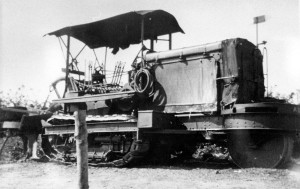 That first spring (1940) the field behind the cottage was a sea of cowslips – a wonderful sight – but one that didn’t last long. A gyrotiller (which I later learned was one of only three in the country and the largest farm machine in use at that time) was called in to destroy the ancient meadow, which was then ploughed and planted with vegetables. It was wheat the last time I saw it (2002); sadly, the cowslips are unlikely ever to be seen there again.
That first spring (1940) the field behind the cottage was a sea of cowslips – a wonderful sight – but one that didn’t last long. A gyrotiller (which I later learned was one of only three in the country and the largest farm machine in use at that time) was called in to destroy the ancient meadow, which was then ploughed and planted with vegetables. It was wheat the last time I saw it (2002); sadly, the cowslips are unlikely ever to be seen there again.
(NB. I later learned that the Gyrotiller was owned [by] Drage and Kent, and operated by Reg Drury and George Harvey.)
The farm machinery was mostly steam-powered, the huge tractors supplied by Drage and Kent providing the power to ploughs, harrows, harvesters and threshing machines. For us boys everything was to its season: rabbitting when the corn was cut, round and round the field gradually working in towards the middle. Eventually rabbits would flee in all directions to be pursued (and sometimes caught) by small boys with cudgels but mostly by their dogs. My gang had a very efficient greyhound even though it had seen better days!
The corn, tied into sheaves, was stooked in the fields to dry and very attractive ‘tents’ they made, too. The sites of many a picnic while gleaning (collecting the wheat which had escaped the machinery and taken home to feed the chickens). It was mostly horses that hauled the carts to the rickyard, each ridden by a small boy feeling very important. In truth, they were just along the for the ride! The horses well-knew that was expected of them and plodded on regardless.
Threshing saw the ricks taken down and fed into the threshing machine, with rats and mice evacuating their homes as best they may, running the gauntlet through a line of the aforementioned small boys backed up by the dogs and cats. Dusty mayhem!
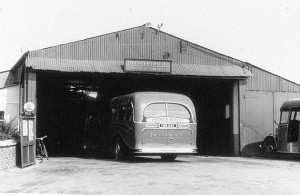 The garage in the centre of the village proved a magnet for the Luftwaffe trying to locate Duxford Aerodrome five miles away. It was bombed (none of them went off) and machine-gunned several times but came to little harm. We had other sightings, too. Walking from the centre of the village north to Rogers’ farm [Wire Farm], a twin-engined bomber flew very low across the fields but as we stood and admired a close-up view of the pilot and crew Thelma (blonde ringlets, surname forgotten and older than me) spotted the crosses and threw us all into the ditch! He disappeared towards Elmdon but never got there, losing out to a Spitfire in a flat dive behind him. I think it was a Heinkel 111 and it came down in Elmdon Woods. We eventually went to hunt for souvenirs but our rivals from Elmdon got there first.
The garage in the centre of the village proved a magnet for the Luftwaffe trying to locate Duxford Aerodrome five miles away. It was bombed (none of them went off) and machine-gunned several times but came to little harm. We had other sightings, too. Walking from the centre of the village north to Rogers’ farm [Wire Farm], a twin-engined bomber flew very low across the fields but as we stood and admired a close-up view of the pilot and crew Thelma (blonde ringlets, surname forgotten and older than me) spotted the crosses and threw us all into the ditch! He disappeared towards Elmdon but never got there, losing out to a Spitfire in a flat dive behind him. I think it was a Heinkel 111 and it came down in Elmdon Woods. We eventually went to hunt for souvenirs but our rivals from Elmdon got there first.
We had other opportunities for wartime souvenirs in the following three years but these were all accidents to our own side!
The coach station belonged to Weedon’s and their coaches were very smartly turned out in red, cream and chocolate. Weedon’s also owned one of the village’s three shops but its main attraction was the orchard behind the garage. There one could find the biggest, sweetest, juiciest apples for miles – but you had to pick your moment. The danger came less from the owners than from their short-tempered Airedale. He only got me once but others were not so lucky. Pigg’s orchard, at the end of the road passing the lane to Broad Green, was also ‘favoured’!
There was also the threat of ‘Ole Briggs’, the village Bobby. He was surprisingly quick for a large man and a clip from his rolled-up cape was not forgotten in a hurry. (No nonsense about ‘Assault’ in those days – if you went home and complained you were likely to get another one and told it served you right!)
- Hedley Hick’s Butchers shop at what is now Mullion Cottage.
- PIgg’s Garage
- Martinholme where Mr Chambers ran the Post Office.
- Weedon’s Shop
Weedon’s ran one of the village’s shops, selling groceries and sweets; Chamber’s, almost opposite, stocked dress materials and was also the Post Office. There was a retail part to Rush’s Garage, next to ‘my’ cottage, and almost opposite that, Hick’s butcher’s shop.
Two large, old farm carts were parked beside the pond opposite Weedon’s shop; these were to have been pushed into the road to stop the advance of Hitler’s tanks should they have ever got this far!
Stan Clarke was the village’s unofficial barber, cheaper than the recognised barber, Charlie Flack, and somewhat less skilled. I think I must have been ‘just visiting’ when he offered me a trim but I was going home to Tottenham for the week-end and told him that I would ‘get a proper haircut’ while I was there. This comment was duly retold to ‘Uncle’! Fortunately, everybody saw the funny side of it. Stan’s cottage and others alongside at right-angles to Church Lane are no more.
I believe there were 14 evacuees at the village church school, under the kindly command of Miss Miller. Try as I might, I can remember only a few of their names – Vera Spooner, Grace White, John Lacey, Clifford Marshall, Charlie Pitt and Ronnie Boultwood. The last-named, walking the footpath between Chrishall and Heydon, was intrigued by the ‘little houses’ in the field so he turned one over to see what it housed. The bees were not amused and Ronnie suffered for his curiosity!
There were also John and Violet Dearn, and John and Ruby Blackett, but they were older than us and rarely seen. John married a local girl, Sylvia Clarke (sadly, since deceased), and still lives in the village. Some of the local boys were Jimmy Whitmore, Derek Weedon and George Hicks, with younger siblings May and Colin. (Their father was the village butcher). Jimmy died in 2002 and Derek, who achieved his ambition to become a jockey and, later, a trainer, passed away earlier than that.
Miss Miller had help from Miss Aitcheson, an Irish teacher who came with us, and Mr Attwood another ‘evacuee’ who quickly left to join the army. Lessons are hardly remembered (although I still have the book prize awarded for ‘General Work’ in 1941) but I do remember skating, sliding and ice-hockey played on Ash Tree Pond in the field behind ‘Jigneys’, which was the field behind the old school (now a private house). We played cricket in Jigneys ‘in season’ but the resident cows made fielding a hazard!
Villages are rarely short of ‘characters’. We had John Brand, the ‘village idiot’ (a traditional sobriquet for one who was but a simple soul) always smiling and waving his walking stick and totally harmless, and the Reverend Hort, also smiling and waving his stick at small boys.
The local dialect has continued to fascinate me and, many years later, has ‘returned’ now that both my daughters have settled in Norfolk – very similar and even more marked. I have a fond memory of ‘Uncle’ referring to one of this many friends ‘… and ole Nat were there with hisun’!
I doubt that any of the 14 Londoners wished upon this little-known village had a bad time, and most of us had a very good time indeed!

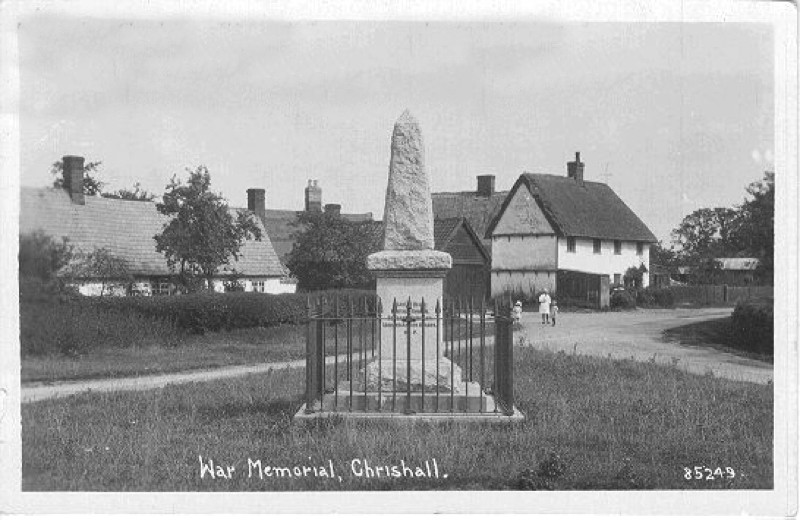

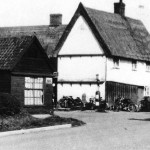
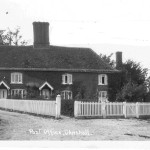
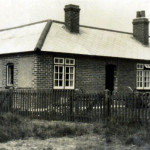

I listened with interest to the stories, particularly Norman Sherry because I don’t remember him at all. He could have been younger than the evacuees that I do remember very well. His memory is a bit like mine, I think, some of the facts are not quite right. The Negus’s elder daughter was Doris, not Rosie. The garage was run by my Grandad, Walter Rush until I came home from the Navy and ran it from 1948 to 1950, Martin Pigg became involved after that, when I moved to S. Walden. I do remember the Dearns, the Blacketts and Vera Spooner, who think had a brother. Also there was John Clements, who lived with Walter Cranwell in Building End, and his sister Joyce. John became interested in the Steam Engines that Mr. Cranwell, who incidentally was my Great Uncle, owned. Then there were brother and sister, Alan and Barbara Kelly, who lived with a family in Crawley End.
As to Spenny Loveday, I’m surprised he didn’t mention that his Dad, Ron., was a demon fast bowler, before he was stricken with polio.